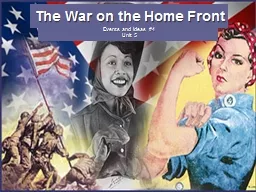

Events and Ideas 4 Unit 5 Essential Question Was Japanese interment just during a time of war Why or why not Compare and contrast life during WWII to life today Contains these Videos Episode 35 ID: 578360
Download Presentation The PPT/PDF document "The War on the Home Front" is the property of its rightful owner. Permission is granted to download and print the materials on this web site for personal, non-commercial use only, and to display it on your personal computer provided you do not modify the materials and that you retain all copyright notices contained in the materials. By downloading content from our website, you accept the terms of this agreement.
Slide1
The War on the Home Front
Events and Ideas #4
Unit 5Slide2
Essential Question
Was Japanese interment just during a time of war
? Why or why not?
Compare and contrast life during WWII to life today.Slide3
Contains these Videos:Episode #35 – World War II – Part 2Complete the worksheet
Wartime RationingAnswer questionsSlide4Slide5
Crash Course Video:World War II – Part 2
Episode #36:Complete the worksheet that goes with the following video:https://www.youtube.com/watch?v=HofnGQwPgqs Slide6
Japanese Internment
Feb
. 19
th
,
1942 – two months after the bombing of Pearl Harbor, FDR authorized the
military to ban
anyone
from the
Pacific Coast.Slide7Slide8Slide9
All people of Japanese ancestry were taken from California, Washington and most of Oregon.Slide10Slide11Slide12
Japanese InternmentSlide13
Japanese Internment110,000 Japanese were placed in camps 62% were American citizensSlide14
Allowed to go HomeJanuary 1945 the exclusion order was rescinded.Japanese began to return home.The freed internees were given $25 and a train ticket to their former places of residence.
Most lost everything they owned while they were in the camps.In 1988 Congress passes legislation apologizing for the internment, and paid reparations of $1.6 millionSlide15
Resident/Enemy AliensAt the start of WWII 11,507 German “enemy aliens” were detained and interned in the U.S.All were either former civilians or citizens of Germany.
German interment camp at Fort MeadeSlide16
ResidentEnemy AliensThere were too many German-American’s to inter them all, instead many were evicted from coastal areas.
36% of the total internments during WWII were Germans.Slide17Slide18
Resident/Enemy AliensOne month after Pearl Harbor was bombed, 600,000 Italians were required to register and carry an “enemy alien registration card” at all times.
By June 1942, 1,521 Italians were arrested by the FBI. Many of them served time in internment camps.Neither the German nor Italian Americans who were interred received apology or reparations.
Two enemy alien registration cards carried by an Italian couple who had lived in the US 30 yearsSlide19
WWII Rationing – Part of Daily LifeSlide20
Wartime Rationinghttps://www.youtube.com/watch?v=9W2jkgs-ugs Slide21
Wartime RationingAnswer the following questions while watching the video (just number them – don’t write the questions):https://www.youtube.com/watch?v=9W2jkgs-ugs
What things were rationed during the war? How many gallons of gas could you get a week?How were women thought of in the 1940’s compared to today?Slide22
Rubber Rationing(write down stats)Slide23
Gas Rationing1942 — Gas rationing was used not to save fuel but to save
tires and the rubber they were made of. A nationwide speed limit of 35 miles per hour was also enforced to save wear on tires. Slide24
Sharing Rides To Save TiresSlide25
Scrap Metal DrivesSlide26
Nylon is RationedDrawing in the seam-line on “Makeup” stockings with a device made from a screw driver handle, bicycle leg clip, and an eyebrow pencil, 1942.Slide27
Scrap PaperPaper was needed for packing weapons and equipment before they were shipped overseasSlide28
Sugar RationingSugar was the first food to be rationed, in the spring of 1942. The war with Japan cut off U.S. imports from the Philippines, and cargo ships from Hawaii were diverted to military purposes.
The nation’s supply of sugar was quickly reduced by more than a third. Slide29
Canned Goods And Ration PointsSlide30
Salvaging Waste FatsSlide31
MeatSlide32
ShoesSlide33
Even TypewritersSlide34
Rosie the Riveter
Not enough men to work in the factories. Employers had to recruit women and minorities. 6 million
women worked
in shipyards, aircraft factories, and other manufacturing plants. Slide35Slide36
Rosie the RiveterWomen were paid 60% of men’s wages for doing the same job.Most of the women lost their jobs when the war was over.Slide37
Essential Question
Was Japanese interment just during a time of war
? Why or why not?
Compare and contrast life during WWII to life today.